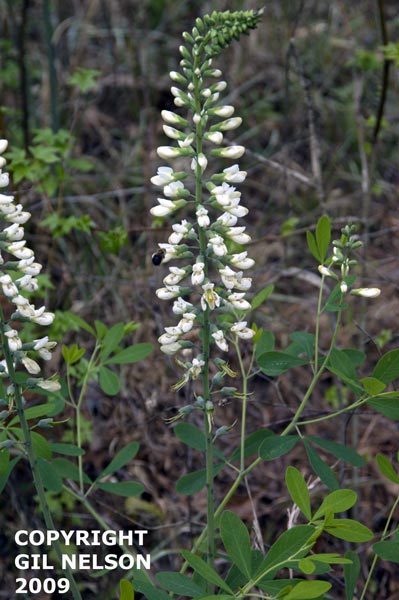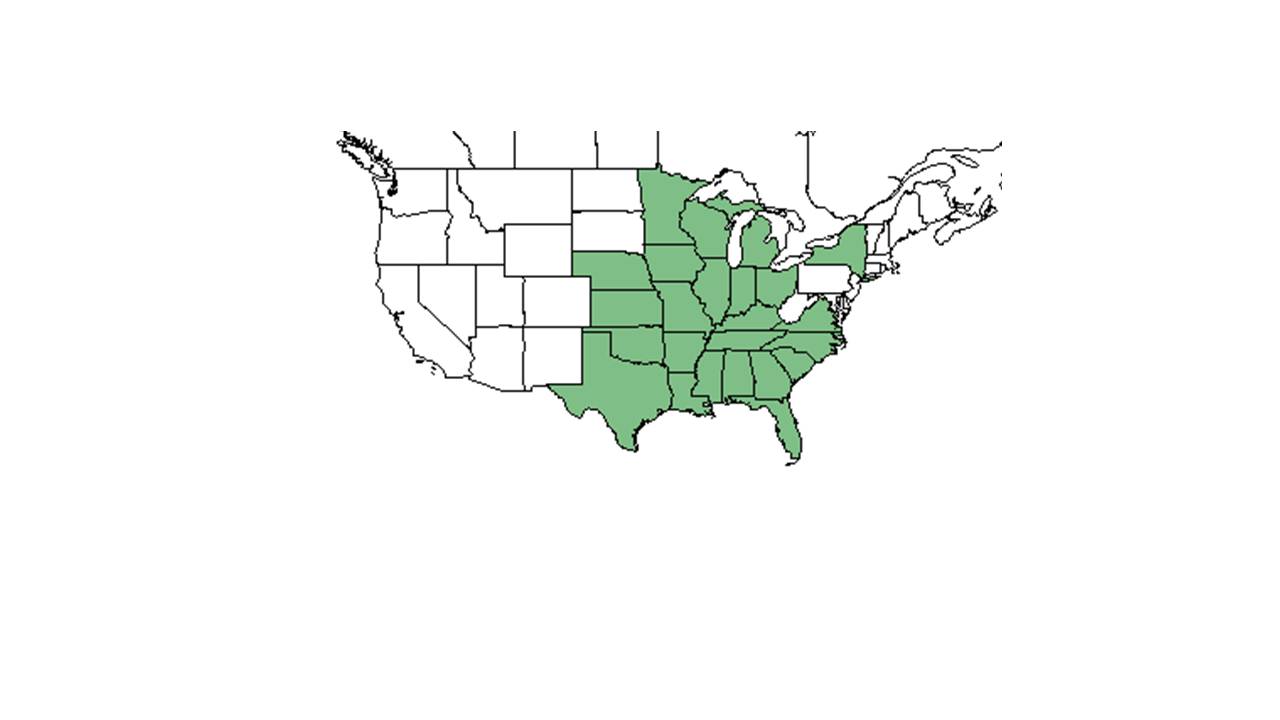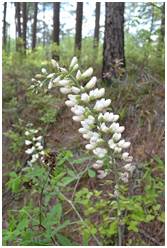Difference between revisions of "Baptisia alba"
(→Description) |
Adam.Vansant (talk | contribs) |
||
| (4 intermediate revisions by 2 users not shown) | |||
| Line 21: | Line 21: | ||
The genus name comes from the Greek word "bapto" meaning to dye, the specific epithet means white.<ref name="missouri">[[http://www.missouribotanicalgarden.org/PlantFinder/PlantFinderDetails.aspx?kempercode=b650]] Missouri Botanical Gardens. Accessed: April 4, 2016</ref> | The genus name comes from the Greek word "bapto" meaning to dye, the specific epithet means white.<ref name="missouri">[[http://www.missouribotanicalgarden.org/PlantFinder/PlantFinderDetails.aspx?kempercode=b650]] Missouri Botanical Gardens. Accessed: April 4, 2016</ref> | ||
| − | Synonyms: ''B. lactea'' (Rafinesque) Thieret var. ''obovata'' (Larisey) Isely; ''B. lactea'' | + | Synonyms: ''B. lactea'' (Rafinesque) Thieret var. ''obovata'' (Larisey) Isely; ''B. lactea'' var. ''pendula'' (Larisey) B.L. Turner; ''B. pendula'' Larisey<ref name=weakley>Weakley, A.S. 2020. Flora of the Southeastern United States. Edition of 20 October 2020. University of North Carolina at Chapel Hill, Chapel Hill, North Carolina.</ref> |
| − | Varieties: | + | Varieties: ''B. pendula'' var. ''obovata'' Larisey<ref name=weakley/> |
==Description== | ==Description== | ||
| Line 37: | Line 37: | ||
===Habitat=== <!--Natural communities, human disturbed habitats, topography, hydrology, soils, light, fire regime requirements for removal of competition, etc.--> | ===Habitat=== <!--Natural communities, human disturbed habitats, topography, hydrology, soils, light, fire regime requirements for removal of competition, etc.--> | ||
''Baptisia alba'' is found dry habitats such as in pine flatwoods, along the edges of mesic thickets and bottomland woodlands, in open upland pine-hardwood sand ridges, well-drained hardwood hammocks, and open upland woods. It can also be found in some disturbed habitats, namely on moist roadsides and along hiking trails and railways. This species appears in a range of light levels, from shady to sunny, and in mostly sandy soil types such as loamy sand and drying sandy loam.<ref name="fsu">Florida State University Robert K. Godfrey Herbarium database. URL: http://herbarium.bio.fsu.edu. Last accessed: June 2014. Collectors: H. E. Ahles, L. C. Anderson, R. Athey, K. E. Blum, M. B. Brooks, J. R. Burkhalter, A. F. Clewell, D.S. Correll, R. F. Doren, W. H. Duncan, L. R. Fox, J. P. Gillespie, R. K. Godfrey, N. C. Henderson, R. H. Houk, G. R. Knight, R. Komarek, R. Kral, R. L. Lazor, R.S. Leisner, K. MacClendon, A. W. Macias, S. McDaniel, R. Mitchell, G. W. Ramsey, J. D. Ray Jr., L. M. Umbach, and R. L. Wilbur. States and Counties: Florida: Calhoun, Dixie, Escambia, Gadsden, Jackson, Jefferson, Lafayette, Leon, Madison, Suwannee, Taylor, Wakulla, and Washington. Georgia: Grady, Fannin, Lowndes, Taliaferro, Thomas, and White. Kansas: Franklin. Mississippi: Hancock and Panola. Missouri: Vernon. North Carolina: Stanly. South Carolina: Lancaster, Richland, and Sumter. Texas: Red River.</ref> | ''Baptisia alba'' is found dry habitats such as in pine flatwoods, along the edges of mesic thickets and bottomland woodlands, in open upland pine-hardwood sand ridges, well-drained hardwood hammocks, and open upland woods. It can also be found in some disturbed habitats, namely on moist roadsides and along hiking trails and railways. This species appears in a range of light levels, from shady to sunny, and in mostly sandy soil types such as loamy sand and drying sandy loam.<ref name="fsu">Florida State University Robert K. Godfrey Herbarium database. URL: http://herbarium.bio.fsu.edu. Last accessed: June 2014. Collectors: H. E. Ahles, L. C. Anderson, R. Athey, K. E. Blum, M. B. Brooks, J. R. Burkhalter, A. F. Clewell, D.S. Correll, R. F. Doren, W. H. Duncan, L. R. Fox, J. P. Gillespie, R. K. Godfrey, N. C. Henderson, R. H. Houk, G. R. Knight, R. Komarek, R. Kral, R. L. Lazor, R.S. Leisner, K. MacClendon, A. W. Macias, S. McDaniel, R. Mitchell, G. W. Ramsey, J. D. Ray Jr., L. M. Umbach, and R. L. Wilbur. States and Counties: Florida: Calhoun, Dixie, Escambia, Gadsden, Jackson, Jefferson, Lafayette, Leon, Madison, Suwannee, Taylor, Wakulla, and Washington. Georgia: Grady, Fannin, Lowndes, Taliaferro, Thomas, and White. Kansas: Franklin. Mississippi: Hancock and Panola. Missouri: Vernon. North Carolina: Stanly. South Carolina: Lancaster, Richland, and Sumter. Texas: Red River.</ref> | ||
| − | ''B. alba'' has shown resistance to regrowth in reestablished longleaf pine woodlands that were disturbed by agricultural practices in South Carolina, making it an indicator species for remnant woodlands.<ref>Brudvig, L.A., E Grman, C.W. Habeck, and J.A. Ledvina. (2013). Strong legacy of agricultural land use on soils and understory plant communities in longleaf pine woodlands. Forest Ecology and Management 310: 944-955.</ref> | + | ''B. alba'' has shown resistance to regrowth in reestablished longleaf pine woodlands that were disturbed by agricultural practices in South Carolina, making it an indicator species for remnant woodlands.<ref>Brudvig, L.A., E Grman, C.W. Habeck, and J.A. Ledvina. (2013). Strong legacy of agricultural land use on soils and understory plant communities in longleaf pine woodlands. Forest Ecology and Management 310: 944-955.</ref> Additionally, ''B. alba'' has been found to be a decreaser in its long-term response following cessation of repeated soil disturbance.<ref name=Dixon>Dixon, C. M., K. M. Robertson, A. M. Reid and M. T. Rother. 2024. Mechanical soil disturbance in a pine savanna has multiyear effects on plant species composition. Ecosphere 15(2):e4759.</ref> |
| − | ===Phenology=== <!--Timing off flowering, fruiting | + | ===Phenology=== <!--Timing off flowering, fruiting, and environmental triggers. Cite PanFlora website if appropriate: http://www.gilnelson.com/PanFlora/ --> |
''B. alba'' grows from a rhizomatous root sytem with a taproot sending up one to several stems.<ref name="friends">[[http://www.friendsofthewildflowergarden.org/pages/plants/falsewhiteindigo.html]]Accessed: April 4, 2016</ref> It exhibits asynchronous flowering.<ref name="petersen">Petersen, C. E., J. B. Ciesielski, et al. (2009). "A two-year study of the reproductive phenology of Baptisia alba (Fabaceae)." Transactions of the Illinois State Academy of Science 103.</ref> Blooms April through July.<ref name="floridata"/> The fruit is a membranous to ligneous legume.<ref name="mehlman">Mehlman, D. W. (1993). "Tumbleweed Dispersal in Florida Sandhill Baptisia (Fabaceae)." Bulletin of the Torrey Botanical Club 120(1): 60-63.</ref> It has been observed to flower in north Florida from March to May and also in December, with peak inflorescence in March and April.<ref>Nelson, G. [http://www.gilnelson.com/ PanFlora]: Plant data for the eastern United States with emphasis on the Southeastern Coastal Plains, Florida, and the Florida Panhandle. www.gilnelson.com/PanFlora/ Accessed: 7 DEC 2016</ref> | ''B. alba'' grows from a rhizomatous root sytem with a taproot sending up one to several stems.<ref name="friends">[[http://www.friendsofthewildflowergarden.org/pages/plants/falsewhiteindigo.html]]Accessed: April 4, 2016</ref> It exhibits asynchronous flowering.<ref name="petersen">Petersen, C. E., J. B. Ciesielski, et al. (2009). "A two-year study of the reproductive phenology of Baptisia alba (Fabaceae)." Transactions of the Illinois State Academy of Science 103.</ref> Blooms April through July.<ref name="floridata"/> The fruit is a membranous to ligneous legume.<ref name="mehlman">Mehlman, D. W. (1993). "Tumbleweed Dispersal in Florida Sandhill Baptisia (Fabaceae)." Bulletin of the Torrey Botanical Club 120(1): 60-63.</ref> It has been observed to flower in north Florida from March to May and also in December, with peak inflorescence in March and April.<ref>Nelson, G. [http://www.gilnelson.com/ PanFlora]: Plant data for the eastern United States with emphasis on the Southeastern Coastal Plains, Florida, and the Florida Panhandle. www.gilnelson.com/PanFlora/ Accessed: 7 DEC 2016</ref> | ||
| Line 51: | Line 51: | ||
It inhabits annually burned pinelands, which implies fire tolerance.<ref name="fsu"/> A deep taproot allows for resprouting after fires.<ref name="floridata"/> There is a greater reproductive productivity in burned areas.<ref name="petersen"/> | It inhabits annually burned pinelands, which implies fire tolerance.<ref name="fsu"/> A deep taproot allows for resprouting after fires.<ref name="floridata"/> There is a greater reproductive productivity in burned areas.<ref name="petersen"/> | ||
| − | ===Pollination | + | ===Pollination=== |
| − | The bee ''Bombus sp.'' is the major pollinators of ''Baptisia alba''<ref name="petersen"/>; ''Bombus bimaculatus'' has been observed pollinating the plant.<ref name= "Grundel">Grundel, R., et al. (2011). "A survey of bees (Hymenoptera: Apoidea) of the Indiana Dunes and Northwest Indiana, USA." Journal of the Kansas Entomological Society 84(2): 105-138.</ref> It is known to be fatal for cows to ingest ''B. alba'', and irritating to humans if ingested. However, it is of special value to native bees since it attracts large numbers.<ref name="wildflower">[[https://www.wildflower.org/plants/search.php?search_field=&newsearch=true]] Lady Bird Johnson Wildflower Center. Accessed: April 4, 2016</ref> | + | The bee ''Bombus sp.'' is the major pollinators of ''Baptisia alba''<ref name="petersen"/>; ''Bombus bimaculatus'' has been observed pollinating the plant.<ref name= "Grundel">Grundel, R., et al. (2011). "A survey of bees (Hymenoptera: Apoidea) of the Indiana Dunes and Northwest Indiana, USA." Journal of the Kansas Entomological Society 84(2): 105-138.</ref> |
| + | |||
| + | ===Herbivory and toxicology=== | ||
| + | It is known to be fatal for cows to ingest ''B. alba'', and irritating to humans if ingested. However, it is of special value to native bees since it attracts large numbers.<ref name="wildflower">[[https://www.wildflower.org/plants/search.php?search_field=&newsearch=true]] Lady Bird Johnson Wildflower Center. Accessed: April 4, 2016</ref> | ||
| + | |||
<!--===Diseases and parasites===--> | <!--===Diseases and parasites===--> | ||
Latest revision as of 13:08, 1 August 2024
| Baptisia alba | |
|---|---|

| |
| photo by Gil Nelson | |
| Scientific classification | |
| Kingdom: | Plantae |
| Division: | Magnoliophyta - Flowering plants |
| Class: | Magnoliopsida - Dicotyledons |
| Order: | Fabales |
| Family: | Fabaceae ⁄ Leguminosae |
| Genus: | Baptisia |
| Species: | B. alba |
| Binomial name | |
| Baptisia alba (L.) Farw. | |

| |
| Natural range of Baptisia alba from USDA NRCS Plants Database. | |
Common name: Thick-pod White Wild Indigo
Contents
Taxonomic notes
The genus name comes from the Greek word "bapto" meaning to dye, the specific epithet means white.[1]
Synonyms: B. lactea (Rafinesque) Thieret var. obovata (Larisey) Isely; B. lactea var. pendula (Larisey) B.L. Turner; B. pendula Larisey[2]
Varieties: B. pendula var. obovata Larisey[2]
Description
For the Baptisia genus, the group are rhizomatous perennial herbs which blacken when dried. The leaves are 3-foliolate or rarely simple. The flowers are papilionaceous (butterfly shaped), either solitary or in axillary or in terminal racemes. The bell-shaped, 4 - 5 lobed calyx is persistent, and the orbicular to reniform petals can be white, cream, yellow or blue in color, and they are usually reflexed and shorter than the wing and keel petals. There are 10 stamens, the filaments are distinct, the ovary is stalk-like in shape, and the legume has a papery to almost woody texture, is inflated, stalked, globose to cylindric in shape, and contains many small seeds.[3]
Specifically, for Baptisia alba, the plants are glaucous and smooth (or close to it) and grow between 0.5 - 1.2 m tall. The leaves contain the 3-foliolate, the leaflets are elliptic, oblanceolate to obovate in shape, and growing up to 2 - 4 (6) cm long, and 0.8 - 1.5 cm wide. The stipules become deciduous, deltoid to lanceolate, and grow up to 5 mm long. The racemes are long, slender, and terminal, and growing up to 15 - 50 cm long. The 2 pedicels grow up to 4 - 12 mm long subtended by temporary bracts that grow up to 5 - 7 mm long. The calyx is smooth (glabrous) except for the short-ciliate margin, and when dried changes to a greenish yellow to straw color. The flower is white in color, and the keel and wing petals grow up to 1.2 - 1.8 cm long. The legume is usually erect, light brown in color, cylindric in shape, and grows up to 2 - 3.5 cm long and up to 5 - 10 mm in diameter.[3]
Distribution
Native to the southeastern United States from Virginia to central Florida.[4]
Ecology
Habitat
Baptisia alba is found dry habitats such as in pine flatwoods, along the edges of mesic thickets and bottomland woodlands, in open upland pine-hardwood sand ridges, well-drained hardwood hammocks, and open upland woods. It can also be found in some disturbed habitats, namely on moist roadsides and along hiking trails and railways. This species appears in a range of light levels, from shady to sunny, and in mostly sandy soil types such as loamy sand and drying sandy loam.[5] B. alba has shown resistance to regrowth in reestablished longleaf pine woodlands that were disturbed by agricultural practices in South Carolina, making it an indicator species for remnant woodlands.[6] Additionally, B. alba has been found to be a decreaser in its long-term response following cessation of repeated soil disturbance.[7]
Phenology
B. alba grows from a rhizomatous root sytem with a taproot sending up one to several stems.[8] It exhibits asynchronous flowering.[9] Blooms April through July.[4] The fruit is a membranous to ligneous legume.[10] It has been observed to flower in north Florida from March to May and also in December, with peak inflorescence in March and April.[11]
Seed dispersal
The legume pod dehisces vertically releasing seeds.[10]
Seed bank and germination
If propagating from seed, they can be soaked in hot water for 1-2 days, and they will germinate within 20 days. Otherwise, they can be scarified (nicking the seed coat with a knife or file before planting) or the root can be divided for a new transplant.[4]
Fire ecology
It inhabits annually burned pinelands, which implies fire tolerance.[5] A deep taproot allows for resprouting after fires.[4] There is a greater reproductive productivity in burned areas.[9]
Pollination
The bee Bombus sp. is the major pollinators of Baptisia alba[9]; Bombus bimaculatus has been observed pollinating the plant.[12]
Herbivory and toxicology
It is known to be fatal for cows to ingest B. alba, and irritating to humans if ingested. However, it is of special value to native bees since it attracts large numbers.[13]
Conservation, cultivation, and restoration
This species takes several years to establish, however, once established it is extremely long lived[4].
Cultural use
A closely related species, B. tinctoria has been historically used to treat scarlet fever, typhus, sore throat, ulcers, and open wounds.[14] It is unknown if all species of Baptisia can be used in these ways.
Photo Gallery
Baptisia alba at Pebble Hill Plantation[15]
References and notes
- ↑ [[1]] Missouri Botanical Gardens. Accessed: April 4, 2016
- ↑ 2.0 2.1 Weakley, A.S. 2020. Flora of the Southeastern United States. Edition of 20 October 2020. University of North Carolina at Chapel Hill, Chapel Hill, North Carolina.
- ↑ 3.0 3.1 .Radford, Albert E., Harry E. Ahles, and C. Ritchie Bell. Manual of the Vascular Flora of the Carolinas. 1964, 1968. The University of North Carolina Press. 580-2. Print.
- ↑ 4.0 4.1 4.2 4.3 4.4 [[2]]Floridata. Accessed: April 4, 2016
- ↑ 5.0 5.1 Florida State University Robert K. Godfrey Herbarium database. URL: http://herbarium.bio.fsu.edu. Last accessed: June 2014. Collectors: H. E. Ahles, L. C. Anderson, R. Athey, K. E. Blum, M. B. Brooks, J. R. Burkhalter, A. F. Clewell, D.S. Correll, R. F. Doren, W. H. Duncan, L. R. Fox, J. P. Gillespie, R. K. Godfrey, N. C. Henderson, R. H. Houk, G. R. Knight, R. Komarek, R. Kral, R. L. Lazor, R.S. Leisner, K. MacClendon, A. W. Macias, S. McDaniel, R. Mitchell, G. W. Ramsey, J. D. Ray Jr., L. M. Umbach, and R. L. Wilbur. States and Counties: Florida: Calhoun, Dixie, Escambia, Gadsden, Jackson, Jefferson, Lafayette, Leon, Madison, Suwannee, Taylor, Wakulla, and Washington. Georgia: Grady, Fannin, Lowndes, Taliaferro, Thomas, and White. Kansas: Franklin. Mississippi: Hancock and Panola. Missouri: Vernon. North Carolina: Stanly. South Carolina: Lancaster, Richland, and Sumter. Texas: Red River.
- ↑ Brudvig, L.A., E Grman, C.W. Habeck, and J.A. Ledvina. (2013). Strong legacy of agricultural land use on soils and understory plant communities in longleaf pine woodlands. Forest Ecology and Management 310: 944-955.
- ↑ Dixon, C. M., K. M. Robertson, A. M. Reid and M. T. Rother. 2024. Mechanical soil disturbance in a pine savanna has multiyear effects on plant species composition. Ecosphere 15(2):e4759.
- ↑ [[3]]Accessed: April 4, 2016
- ↑ 9.0 9.1 9.2 Petersen, C. E., J. B. Ciesielski, et al. (2009). "A two-year study of the reproductive phenology of Baptisia alba (Fabaceae)." Transactions of the Illinois State Academy of Science 103.
- ↑ 10.0 10.1 Mehlman, D. W. (1993). "Tumbleweed Dispersal in Florida Sandhill Baptisia (Fabaceae)." Bulletin of the Torrey Botanical Club 120(1): 60-63.
- ↑ Nelson, G. PanFlora: Plant data for the eastern United States with emphasis on the Southeastern Coastal Plains, Florida, and the Florida Panhandle. www.gilnelson.com/PanFlora/ Accessed: 7 DEC 2016
- ↑ Grundel, R., et al. (2011). "A survey of bees (Hymenoptera: Apoidea) of the Indiana Dunes and Northwest Indiana, USA." Journal of the Kansas Entomological Society 84(2): 105-138.
- ↑ [[4]] Lady Bird Johnson Wildflower Center. Accessed: April 4, 2016
- ↑ Korchmal, Arnold & Connie. 1973. A Guide to the Medicinal Plants of the United States. The New York Times Book Company, New York.
- ↑ Photographed and identified by Kevin Robertson at Pebble Hill
